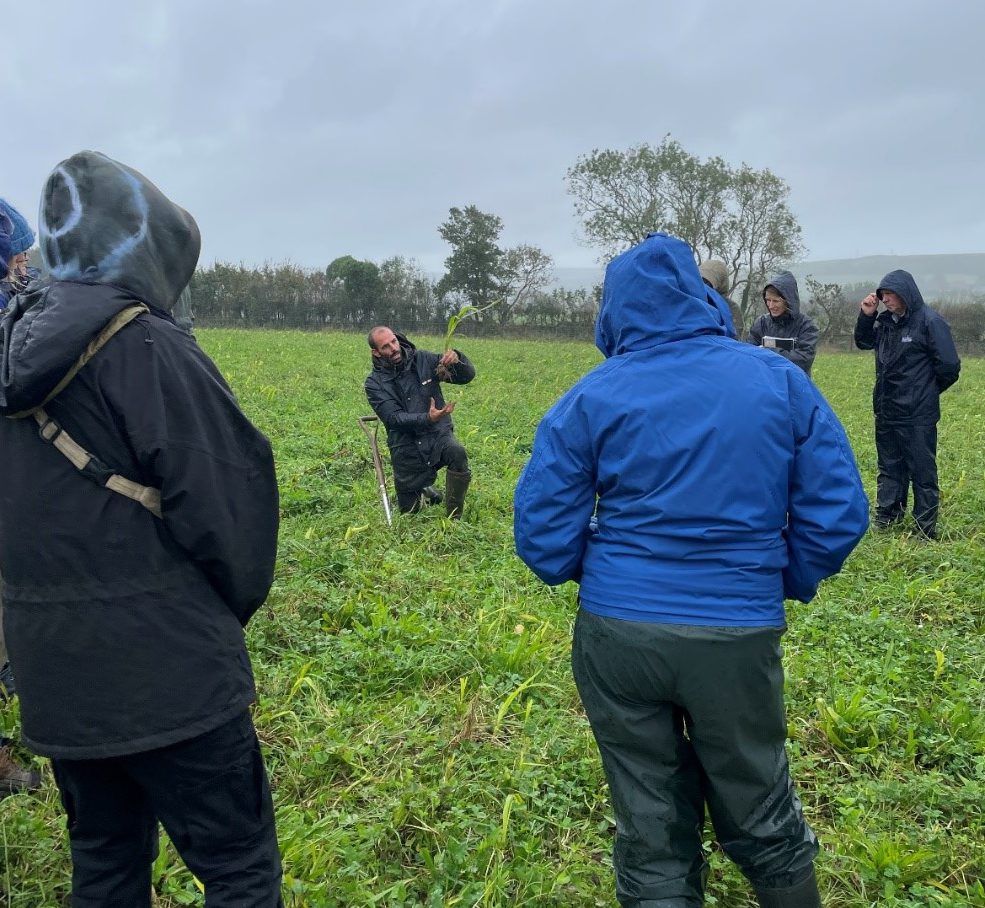
Written by Alex Bebbington, Project Officer, Rural Business School, Duchy College
Wednesday 18th October 2023
Tim Williams has now completed three years of a contract farming agreement with Antony Estates, working to convert Erth Barton into a regenerative farming system, rebuilding soil fertility. This event was a chance to hear about some of the successes and challenges encountered during the transition. This event was made possible with thanks to the National Lottery Community Fund who fund the Farm Net Zero project.
Tim took on the 300-acre (121 hectare) farm in two halves, arriving with very little kit and limited funds for inputs. This has meant he has built a simple, zero-input system focusing on restoring and feeding the soil microbiology in order to provide fertility.
A very diverse cover crop/herbal ley was drilled to increase rooting depth and diversity and then grazed with beef cattle (averaging 0.8 Livestock Units per hectare) with the aim to eat a third, trample a third and leave a third. Tim has learnt that it is best to focus on managing grass to build up a reserve rather than eating into it. Frequent moves leave grass to regrow, meaning there is always grass ahead of the livestock throughout the rotation.
Another method Tim has trialled to improve soil microbiology has been applications of compost created using a system called “complete microbial composting” developed by the Land Gardeners. This involves mixing brown (cattle dung, soil, straw) and green (fresh cut plants) material from around the farm in long windrows and turning. Three methods of application were trialled – direct spreading, compost tea brewing and “biopriming” (mixing compost with the seed prior to drilling). Tim felt that the biopriming technique has the potential to be the most successful. However, soil microbial testing conducted by the University of Exeter showed no difference so far between areas with and without compost application.
Tim has also experimented with pasture cropping alongside WildFarmed, this involved using a Moore Unidrill to direct drill a heritage wheat blend into a hard-grazed herbal ley. The aim was for the existing ley to provide ground cover and nitrogen-fixation. Tim described the first attempt at pasture cropping as a “disaster”, with chicory swamping the wheat and making harvest impossible. A second attempt meant tweaking the herbal ley mix to make it less competitive, grazing tight, sub-soiling and spring tine harrowing for seed/soil contact and then direct drilling. This appeared to have good establishment up until May, at which point Tim noticed that about two-thirds of the crop was Westerwolds grass. Again, harvest was abandoned and the field grazed instead to utilise the crop and keep organic matter in the field. In future, Tim plans on removing grass from the mix and replacing with a species that has more winter-kill such as sunflowers/millet/sorghum.
As Tim’s time at Erth Barton draws to a close, we would like to thank him for his work on Farm Net Zero and wish him all the best for his future endeavours.
Key takeaways:
- Bringing pasture and livestock back onto the farm has helped to improve soil quality.
- Fertility extraction should be balanced with fertility building. This can be done as part of a rotation.
- Even when experiments do not go the way we first thought, we can still learn valuable lessons from them.
